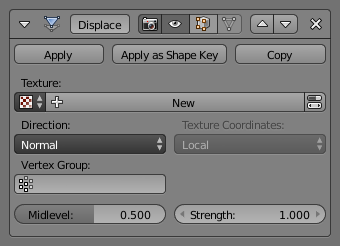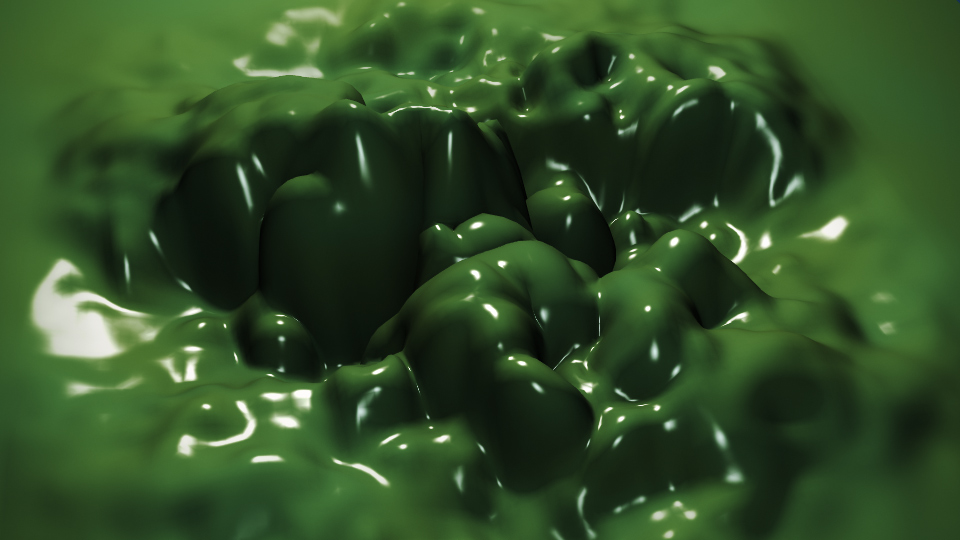Displace Modifier¶
The Displace Modifier displaces vertices in a mesh based on the intensity of a texture. Either procedural or image textures can be used. The displacement can be along a particular local axis, along the vertex normal, or the separate RGB components of the texture can be used to displace vertices in the local X, Y and Z directions simultaneously (sometimes referred to as Vector Displacement).
Options¶

Displace Modifier.
- Texture
- The name of the texture from which the displacement for each vertex is derived. If this field is empty, the modifier defaults to 1.0 (white).
- Direction
The direction along which to displace the vertices. Can be one of the following:
- X, Y, Z
- Displace along an axis.
- Normal
- Displace along the vertex normal.
- Custom Normal
- Displace along (averaged) custom normals, instead of vertex normals.
- RGB to XYZ
- Displace along local XYZ axes individually using the RGB components of the texture (Red values displaced along the X axis, Green along the Y, Blue along the Z). This is sometimes referred to as Vector Displacement.
- Space
- With a direction set to X, Y, Z, or XYZ the modifier can either displace along local or global axes.
- Texture Coordinates
The texture coordinate system to use when retrieving values from the texture for each vertex. Can be one of the following:
- UV
Take texture coordinates from face UV coordinates.
- UV Map
- The UV map from which to take texture coordinates. If the object has no UV coordinates, it uses the Local coordinate system. If this field is blank, but there is a UV map available (e.g. just after adding the first UV map to the mesh), it will be overwritten with the currently active UV map.
Obs
Since UV coordinates are specified per face, the UV texture coordinate system currently determines the UV coordinate for each vertex from the first face encountered which uses that vertex; any other faces using that vertex are ignored. This may lead to artifacts if the mesh has non-contiguous UV coordinates.
- Object
Take the texture coordinates from another object’s coordinate system (specified by the Object field).
- Object
The object from which to take texture coordinates. Moving the object will therefore alter the coordinates of the texture mapping.
Take note that moving the original object will also result in a texture coordinate update. As such, if you need to maintain a displacement coordinate system while moving the modified object, consider parenting the coordinate object to the modified object.
If this field is blank, the Local coordinate system is used.
- Global
- Take the texture coordinates from the global coordinate system.
- Local
- Take the texture coordinates from the object’s local coordinate system.
- Vertex Group
- The name of a vertex group which is used to control the influence of the modifier. If left empty, the modifier affects all vertices equally.
- Midlevel
The texture value which will be treated as no displacement by the modifier. Texture values below this value will result in negative displacement along the selected direction, while texture values above this value will result in positive displacement.
displacement = texture_value - Midlevel
Recall that color/luminosity values are typically between (0.0 to 1.0) in Blender, and not between (0 to 255).
- Strength
The strength of the displacement. After offsetting by the Midlevel value, the displacement will be multiplied by the Strength value to give the final vertex offset.
vertex_offset = displacement × Strength.
A negative strength can be used to invert the effect of the modifier.
Example¶

Three different objects created with the Displace modifier. Sample blend-file.

A slime animation created with the Displace modifier. Sample blend-file.